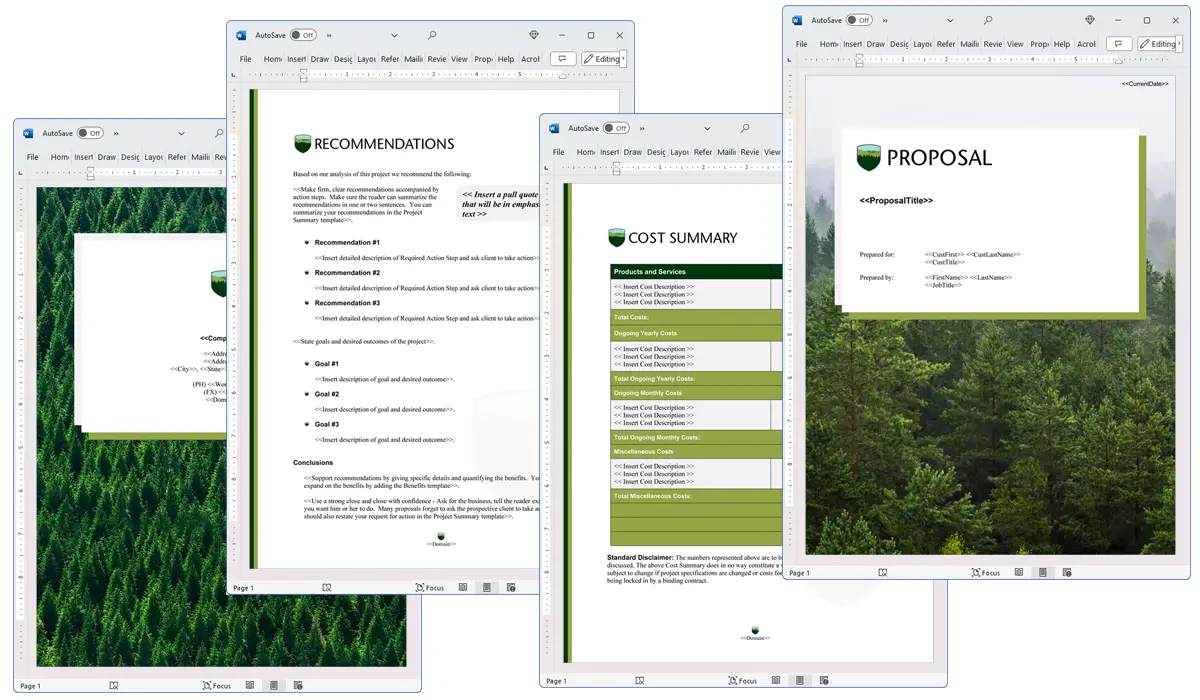What is the Capital Costs chapter used for?
Proposal Kit Professional Bundle adds more design themes, all six Contract Packs,
a project management library, and Expert Edition software.

Illustration of Proposal Pack Nature #9
We include this Capital Costs chapter template in every Proposal Pack, along with thousands more. You assemble this chapter with others in various combinations to create custom-tailored business proposals, plans, reports, and other documents. Proposal Packs apply custom visual designs to the templates, giving the final documents a consistent professional finish.
 DOWNLOADABLE, ONE-TIME COST, NO SUBSCRIPTION FEES
DOWNLOADABLE, ONE-TIME COST, NO SUBSCRIPTION FEES
Overview of the Capital Costs Chapter
In the field of business proposals, the 'Capital Costs' chapter is crucial for detailing the upfront expenses associated with initiating a project or business operation. This chapter helps in painting a clear picture of the financial commitment required for fixed assets like land, buildings, and equipment which are important for the establishment and foundational activities of a business. These costs are generally non-recurring, making it important to outline them separately from ongoing operational expenses in any business proposal.
How is the Capital Costs Chapter Used?
The 'Capital Costs' chapter is typically used in business proposals to provide a detailed breakdown of the initial investments needed to start or expand a project. This includes acquiring or upgrading physical assets that will serve the business for a long time. By presenting this information, businesses can justify the necessity of these expenses to stakeholders and potential investors, showing how these costs contribute to the long-term success and sustainability of the business. It also serves as a basis for discussing financing options and expected returns on these investments.
What is Included in the Capital Costs Chapter?
This chapter generally encapsulates several key elements:
- Detailed List of Capital Expenditures: This includes the cost of acquiring land, buildings, major equipment, and technology necessary for the business.
- Installation and Setup Costs: Costs related to the construction or remodeling of facilities and the installation of equipment.
- Initial Licensing Fees: Any fees associated with obtaining the licenses required to operate legally.
- Financing Details: How the capital costs will be financed, whether through loans, investor funding, or other financial instruments.
- Return on Investment (ROI): An analysis or forecast of how long it will take for the capital investments to pay off.
Use Case Examples for the Capital Costs Chapter
- Real Estate Development Proposals: Detailing the costs for acquiring land and constructing buildings.
- Manufacturing Plant Setup: Outlining the expenses for purchasing machinery and setting up a production line.
- Tech Startup Proposals: Including costs for purchasing high-end computers and software licenses.
- Hospitality Business: Estimating costs for renovating a property into a hotel or restaurant.
- Educational Institutions: Budgeting for campus expansions or the construction of new facilities.
Key Takeaways
- The 'Capital Costs' chapter is important for outlining the initial, non-recurring expenses in a business proposal.
- It differentiates between one-time capital expenses and ongoing operational costs.
- This chapter helps in demonstrating the financial feasibility and sustainability of a project to investors.
- It includes detailed descriptions of assets, setup costs, licensing, and financing strategies.
- Effective use of this chapter can significantly enhance the persuasiveness and clarity of a business proposal.

Illustration of Proposal Pack Children #3
 What Our Clients Say
What Our Clients SaySo far, so good!! It’s a well thought out application solution."
Managing Principal
Business Development at AAF Consulting Group
 4.7 stars, based on 845 reviews
4.7 stars, based on 845 reviewsAlternate Chapters
Related Chapters

The Capital Costs chapter and other chapters are integrated into a Word document as illustrated here in the Proposal Pack Travel #5 design theme. There are hundreds of design themes available, and every design theme includes the Capital Costs chapter template.
A proper business proposal will include multiple chapters. This chapter is just one of many you can build into your proposal. We include the complete fill-in-the-blank template in our Proposal Pack template collections. We also include a library of sample proposals illustrating how companies in different industries, both large and small, have written proposals using our Proposal Packs. This template will show you how to write the Capital Costs.
We include a chapter library for you to build from based on your needs. All proposals are different and have different needs and goals. Pick the chapters from our collection and organize them as needed for your proposal.
Using the Proposal Pack template library, you can create any business proposal, report, study, plan, or document.
 Ian Lauder has been helping businesses write their proposals and contracts for two decades. Ian is the owner and founder of Proposal Kit, one of the original sources of business proposal and contract software products started in 1997.
Ian Lauder has been helping businesses write their proposals and contracts for two decades. Ian is the owner and founder of Proposal Kit, one of the original sources of business proposal and contract software products started in 1997.By Ian Lauder
 Published by Proposal Kit, Inc.
Published by Proposal Kit, Inc.


 Cart
Cart
 Facebook
Facebook YouTube
YouTube X
X Search Site
Search Site